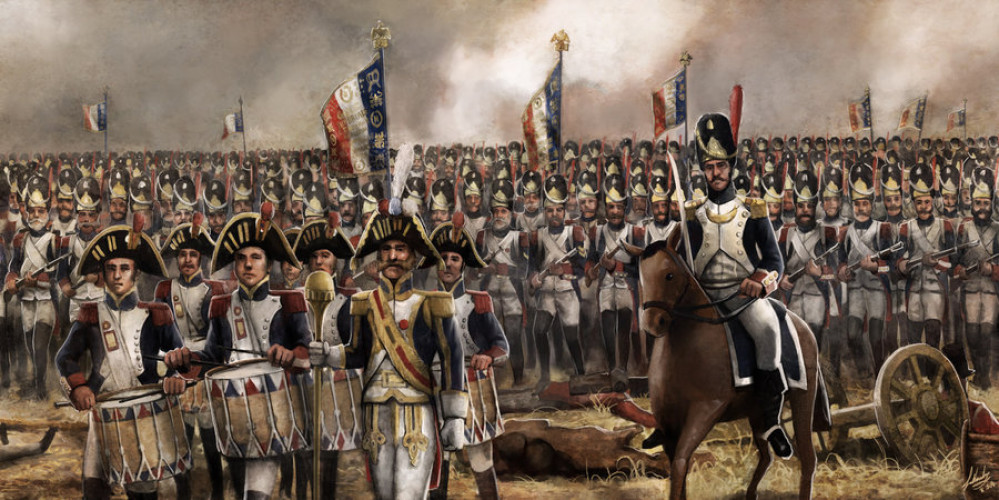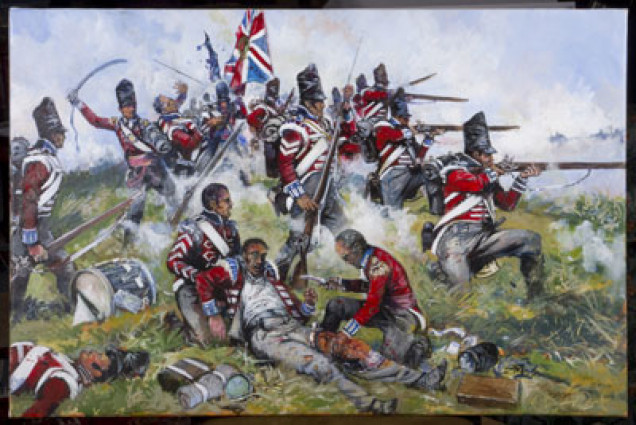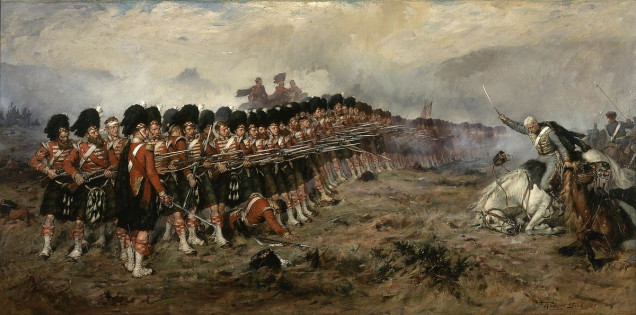
Elessar2590's Grande Armee Project
Make Ready! Present! Fire!
A Brief Explanation of Shooting in "Napoleon at War"
Time for another breakdown of “Napoleon at War” this time we’ll look at shooting, casualties and how this enhances the overall feel of the game.
Shooting is very standard. If you’re an infantryman with a gun your range is 6 Inches. That’s it. Rifles, Light Infantry and Russian Conscripts doesn’t matter they all fire 6 inches.
Also, if you’re within 6 inches you must fire or at least you must declare you’re firing even if you don’t actually want to fire. Basically, if you’re within 6 inches of an enemy you must declare you’re firing at that unit even if you then choose to not roll any dice, this is more important later when we get to counter firing.
Hitting is also straight forward, everything hits on a four. From Conscripts to Guard they all hit on fours. Elite units get extra dice to represent their superiour drill while poorly trained units must reroll successful hits but still the target is four.
Being hit is again very simple and works on the four-plus mechanic. Four hits automatically remove a base while one to three hits mean you must take a save. You can’t play “Musical Wounds” and turn six hits into six save attempts, six hits are a dead base and a save roll.
Saving is easy and there’s a simple trick to easily know your save roll, number of hits plus one. (For those mathematically inclined the formula for that is (S=n+1 where S is the save roll and n is the number of hits, wow all those years of Uni and High School are starting to pay off ?)one hit is saved on a two, two hits are saved on a three and three hits are saved on a four and four hits are a kill.
But how do actually know how many dice to roll? It’s all well and good hitting and killing but it’s the dice that we’re all here for. Well this again is easy, no matter what type of infantry you are you fire 2d6 for each base if you didn’t move and d6 per base if you did move.
So your dastardly Russians advance into firing range of my noble (and mustachioed) Frenchmen, your Russian Peasants will fire a pathetic d6 dice per base whereas my glorious soldiers shall be getting a mighty 2d6 per base. The game encourages you to wait and gather your forces rather than just rush headlong into combat.
The eagle eyed amongst you may have noticed that while painting my French Battalion I also had two stands of two miniatures. Those are the units skirmish stands. Almost all units have two skirmish stands and these represent the thin screen of skirmishers sent out in front of the unit to harass the enemy and engage the enemies’ skirmishers.
Each Skirmish stand reduces the enemies dice by one. If you have two skirmish stands then your opponent rolls one or two d6 per base as normal but removes one dice for each skirmish base. Skirmish bases can also be destroyed if the enemy rolls three of the same result when rolling to hit. So if the enemy rolls three ones that’s a skirmish base destroyed, there are no saves, and the same if the enemy rolls three fives, that’s a dead skirmish base and a four-plus save on a normal base. Skirmish bases do not soak up dice so three fives still cause casualties on the “parent” unit and kill a base.
A unit can never have more skirmish bases than “parent” bases. So, a unit with one “parent” base and two skirmisher bases must remove one of the skirmishers.
Last thing about skirmishers, if you’re firing into the enemies’ flank rather than take away dice (since the enemy can’t fire back) they add d6 per base to your firing pool. They also have a chance of panicking when charged by cavalry, but I’ll save that for the melee section
If a unit is fired upon (remember you must fire even if you decline to actually fire/roll the dice) then the target unit gets to return fire. Other units which have the enemy in their firing arc may also return fire in the form of Supporting Fire which adds a single d6 to the return fire representing a few men taking, unordered, pot shots or the unit returning fire being urged on by their allies’ presence.
Returning fire is exactly the same as normal firing except that the target must be the unit that fired at them. A unit may return fire and add supporting fire any number of times in a single turn.
Artillery are a little different to normal units. They still hit on a four-plus but can fire either canister or solid shot. Canister has a range of six inches so if your cannons are firing canister the enemies’ firing back.
Artillery fires just like infantry so each base rolls 2d6 (3d6 for canister) halving the dice if the unit moved. However, each hit on the target unit then gets rerolled and on the result of a six the next unit behind them received a hit continuing until all potential targets are hit or anything but a six is rolled. This represents the shot ricocheting past the original target or just plain panicking units in their arc of fire, casualties aren’t all necessarily dead they could also be troops who fled or troops who remain in formation but who are essentially useless to their commander.
Speaking of Commanders, where would a Napoleonic Wargame be without the prospect that our brave (and pretty essential) Officers could take one for the team?
If an officer is attached to a unit which took fire, whether hits were caused or not, rolls 2d6 and on an eleven-plus the officer is wounded/killed. Officers within six inches of the enemy must also roll to see if they are hit.
If the unit a Commander is attached to is killed he is assumed to be either killed, wounded, trying to rally the unit or as the Vietnam guys would say “fragged”.
Now we’ve all seen Sharpe (if you haven’t stop RIGHT HERE and go watch it or even better watch it and read the books or audiobooks) so we all know that a Rifleman can be a death sentence for an enemy officer.
If an officer has to roll a casualty check and the unit which caused the roll, either by being within six inches or being a unit that fired on his “parent” unit, is killed on a ten-plus rather than an eleven-plus.
This isn’t just a Rifleman rule, it can also apply to Prussian Jagers or French Tirailleurs. If the unit had a reputation for Marksmanship they normally have this rule.
Lastly the easiest one, Cavalry. Cavalry don’t play nice, see normally the enemy kindly stands there, neat and tidy and takes it like a man. Cavalry have this weird habit of running away or at least running out of firing arcs.
Cavalry can take a test, the score depends on the type of cavalry, and if they pass they can make a free move out of the units firing zone. They can do this as many times as necessary in a turn so long as they keep passing their tests.
The score a cavalry unit needs to beat in order to make this maneuver depends on its historical performance. Polish Lancers are better at it than British Hussars.
So that’s pretty much it for shooting. More painted minis coming soon (I’ve recently acquired the Lannister half of “A Song of Ice and Fire” so that’s very distracting).













































































Epic breakdown on some of the Napoleonic combat system, @Elessar2590 ! For the Saratoga article series, @aras and I played around with getting TSR Battlesystem to play for AWI … I see SOME similarities here. Our system worked well for AWI, but I wouldn’t trust it with the scale of Napoleonics, so this is really interesting!